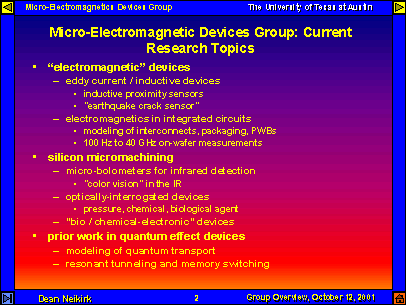A total of people have visited this page since 1/19/96.

This work concentrates on the design of new micro-sensors and actuators,
constructed using integrated circuit fabrication techniques and silicon
micromachining. Since there are many classical devices that sense most quantities
of interest, it is critical to first identify an application that will benefit
from the application of IC-like fabrication. This suggests either very high
volume requirements (since IC fabrication can produce parts of low cost,
but generally only if the devices are produced in very large numbers), or
situations in which the size of the device must be quite small.
Current emphasis is the design-for-manufacture of optically-interrogated
pressure micro transducers, and in the fabrication of a new inductive proximity sensor. We
are also applying micromachining to a completely new area, hydrodynamic
bearings. This work should produce patterned surfaces that maximize
the performance of mechanical bearings, as well as allow the integration
of sensors directly into a bearing. We are also studying the use of micromachined
devices for chemical and biological
agent sensors .
Y. Kim and D. P. Neikirk, "Surface
Micromachined Fabry-Perot Pressure Transducer with Optical Fiber Interconnect,"
volume SPIE 2642, Micromached Devices and Components, Austin, Texas, USA,
23-24 October, 1995, pp. .
V. Gupta and D. P. Neikirk, "Design
of an Inductive Proximity Sensor using a Two-Coil Planar Transformer,"
volume SPIE 2642, Micromached Devices and Components, Austin, Texas, USA,
23-24 October, 1995, pp. 173-182.
J. Han and D. P. Neikirk, "Deflection behavior of Fabry-Perot pressure sensors having planar and corrugated membrane," SPIE's Micromachining and Microfabrication '96 Symposium: Micromachined Devices and Components II, R. Roop and K. Chau, Proc. SPIE 2882, Austin, Texas, USA, 14-15 October, 1996, pp. 79-90.
J. J. Lavigne, S. Savoy, M. B. Clevenger, J. E. Ritchie, B. McDoniel,
S.-J. Yoo, E. V. Anslyn, o. T. McDevitt, J. B. Shear, and D. Neikirk, "Solution-Based Analysis of Multiple Analytes
by a Sensor Array: Toward the Development of an "Electronic Tongue","
JACS, vol. 120, July 1, 1998, pp. 6429-6430.
Some Publications on Micromachined Sensors and Actuators
Today it is possible to fabricate semiconductor structures with layers as
thin as only a few tenths of a nanometer. The behavior of such structures
is governed by quantum mechanical phenomena. Our research in this area concentrates
on the use of tunneling structures built using molecular beam epitaxy, in
particular quantum well devices. We have done extensive work on double barrier resonant tunneling diodes (DBRTDs)
and their application to microwave and millimeterwave oscillators. We have
also studied a new phenomena in these diodes that gives rise to memory switching that may
have interesting applications in digital logic and information storage.
Some Publications on Quantum Well Devices
In this phase of our work we have concentrated on the development of
efficient methods for the modeling of frequency-dependent resistance and
inductance in MCM interconnects. Since the geometrical cross-sections of
MCM-level (i.e., inter-chip interconnects) interconnects are relatively
large (compared to intra-chip interconnects) their resistance can be quite
low, and so their behavior is influenced by not only their capacitance and
resistance, but also by their inductance. In addition, inductive cross-talk
may be significant for inter-chip interconnects. These effects are intimately
related to the distribution of current across the cross-section of the interconnects,
that in turn, is influenced by interactions with other conductors (external
proximity effects) and by the skin effect (internal proximity effects).
Although these processes can be approximated using magneto-quasi-statics,
they are inherently frequency dependent. Conventional "full wave"
electromagnetic calculations of the frequency dependent series impedance
(i.e., the resistance and inductance of the interconnect) are numerically
intensive, making them unsuitable for CAD tools. We have developed several
new approaches that provide excellent accuracy, along with a significant
improvement in computation speed. For instance, by combined a new effective
internal impedance with the current-filament method for extraction we have
achieved excellent accuracy with at least a 100 times reduction in computation
time. Comparison between conventional and our new "surface-ribbon"
calculations (see our Interconnect
Series Impedance Calculator) over a wide range of conductor geometries
(including high aspect ratio cross-sections, such as square conductors)
has shown excellent agreement from dc to 100 GHz.
B.-T. Lee, E. Tuncer, and D. P. Neikirk, "Efficient
3-D Series Impedance Extraction using Effective Internal Impedance,"
IEEE 4th Topical Meeting on Electrical Performance of Electronic Packaging,
Portland, OR, Oct. 2-4, 1995, pp. 220-222.
S. Kim and D. P. Neikirk, "Compact Equivalent Circuit Model for the
Skin Effect," IEEE 1996 IEEE-MTT-S International Microwave Symposium,
editor: R. G. Ranson, Vol. 3, San Francisco, California, June 17-21, 1996,
pp. 1815-1818. A post script version of the poster presented at the 1996
International Microwave Symposium (held in San Francisco, June 17-21, 1996)
can be down-loaded
here (file is approximately 400K in size); pdf
version also available.
Some Publications on Interconnects and Transmission Lines
A short paper on modeling Schottky-contacted
coplanar waveguide on epitaxial semiconducting substrates. This device
can be used as either a phase shifter or a delay line.
Some Publications on Coplanar Waveguide
Devices
Dean P. Neikirk, "Micro-sensors
- what happens when you make "classical" devices "small":
integrated bolometric radiation detectors"
Some Publications on Planar Antennas
and Infrared Detectors
A short paper on twin
slot antennas and integrated microbolometers for millimeter to submillimeter
wavelength detection.